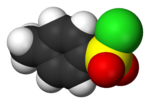4-toluenesulfonyl chloride
 |
|
 |
|
| Names | |
|---|---|
|
IUPAC name
4-methylbenzenesulfonyl chloride
|
|
| Other names
Tosyl chloride, p-toluenesulfonyl chloride, p-TsCl, TsCl
|
|
| Identifiers | |
|
3D model (JSmol)
|
|
| ChemSpider | |
| ECHA InfoCard | 100.002.441 |
|
PubChem CID
|
|
|
|
|
|
| Properties | |
| C7H7ClO2S | |
| Molar mass | 190.65 g/mol |
| Appearance | White solid |
| Melting point | 65 to 69 °C (149 to 156 °F; 338 to 342 K) |
| Boiling point | 134 °C (273 °F; 407 K) at 10 mmHg |
| Hydrolysis | |
| Hazards | |
| Main hazards | Releases acid |
| NFPA 704 | |
| Flash point | 128 °C (262 °F; 401 K) |
|
Except where otherwise noted, data are given for materials in their standard state (at 25 °C [77 °F], 100 kPa).
|
|
|
|
|
| Infobox references | |
4-Toluenesulfonyl chloride (p-toluenesulfonyl chloride, toluene-p-sulfonyl chloride) is an organic compound with the formula CH3C6H4SO2Cl. This white, malodorous solid is a reagent widely used in organic synthesis. Abbreviated TsCl or TosCl, it is a derivative of toluene and contains a sulfonyl chloride (-SO2Cl) functional group.
In characteristic manner, TsCl converts alcohols (abbreviated ROH) into the corresponding toluenesulfonate esters, or tosyl derivatives ("tosylates"):
Tosylates can be cleaved with lithium aluminium hydride:
Thus, tosylation followed by reduction allows for removal of a hydroxyl group.
Likewise, TsCl is used to prepare sulfonamides from amines:
The resulting sulfonamides are non-basic and, when derived from primary amines, are even acidic.
The preparation of tosyl esters and amides are conducted in the presence of a base, which absorbs hydrogen chloride. The selection of the base is often crucial to the efficiency of tosylation. Typical bases include pyridine and triethylamine. Unusual bases are also used; for example, catalytic amounts of trimethylammonium chloride in the presence of triethylamine is highly effective by virtue of the trimethylamine.
Being a widely available reagent, TsCl has been heavily examined from the perspective of reactivity. It is used in dehydrations to make nitriles, isocyanides and diimides. In an unusual reaction focusing on the sulfur center, zinc reduces TsCl to the sulfinate, CH3C6H4SO2Na.
TsCl is inexpensively available for laboratory use. It is a by-product from the production of o-toluenesulfonyl chloride (a precursor for the synthesis of saccharin), via the chlorosulfonation of toluene:
...
Wikipedia

